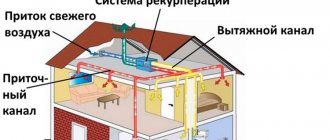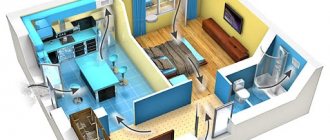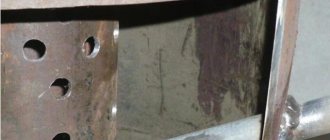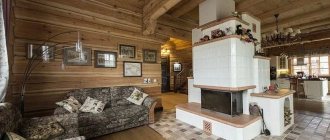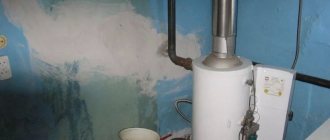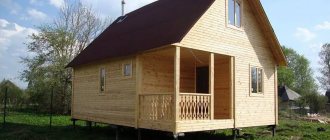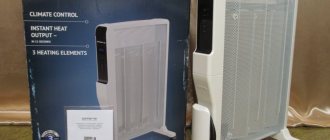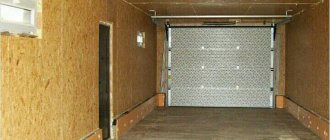In basements where vegetables and other food supplies are stored, it is especially important to establish air exchange. Otherwise, the room may become damp and the products will become unusable. Many people set up a garage cellar for storage, and you shouldn’t forget about ventilation in it: this can lead not only to dampness due to the accumulation of condensation, but also to the complete destruction of the entire building.
Garage owners often strive to use every square meter of land they own. It is for this purpose that a cellar or basement is equipped underground for storing valuables or preparations for the winter. Few people think that it is necessary to provide suitable conditions to maintain a stable microclimate in this room. However, even in a garage with a basement, proper ventilation is essential.
By ensuring optimal air exchange, many negative consequences can be avoided . These include:
- Formation of condensation on the walls. Because of this, the humidity in the cellar increases, which leads to the appearance of mold and mildew, which spoil the things in the room. If this happens where vegetable or fruit stocks are stored, they run the risk of spoiling very quickly.
- The top part of the garage cools down much faster than the underground part, so it will always be hotter in the basement than above ground. This can cause moisture to accumulate below, evaporate and rise into the garage. This will result in damage to the car or motorcycle, as well as the tools stored next to them.
- Sometimes garages store things that would cause too much inconvenience at home: various fuels and lubricants and chemicals. When they evaporate, toxic substances are released that are dangerous to people. If they accumulate indoors, a person faces poisoning and even death. Proper ventilation helps to avoid this threat: fresh air from the environment will constantly flow, diluting the concentration of toxins, and they themselves can gradually erode.
Therefore, although it may seem that installing hoods and fans in non-residential premises is an unnecessary luxury, you cannot do without them. Their absence can lead to many undesirable consequences that will negate the benefits of using additional space.
Features of winter garage ventilation
In most cases, garage ventilation in winter is arranged based on the temperature difference between the “internal” heat of the heated room and the “external” flow of the freezing environment.
Moreover, from the point of view of the energy efficiency of air exchange, such a basis looks very attractive - natural ventilation will work as if on its own, without consuming energy. However, from a functional point of view, “temperature” ventilation may be insufficient due to the low rate of outflow of air masses, which will lead to the accumulation of condensation of water vapor on the car and the walls of the garage. After all, a vehicle body soaked in moisture will rust in just a couple of seasons.
The car is in the garage
Therefore, in this article we will try to find a compromise between the speed and energy efficiency of garage ventilation in the cold season.
Internal insulation of the garage
Ventilation may not cope with condensation - you may need to insulate the garage from the inside to change the location of the dew point. To do this, choose moisture-resistant materials with low thermal conductivity. Most garages in Russia are insulated with polystyrene foam, although its modern analogues, polystyrene foam or penoizol, are thicker and insulate better.
To insulate a garage, it is not recommended to use mineral wool and other fibrous materials, which get wet, lose their properties and inevitably lead to local disasters in the garage.
Alexb4FORUMHOUSE Member
I insulated the ceiling in the garage with mineral wool, which I don’t recommend. When the temperature changed, condensation accumulated on the floor slab, and as soon as the stove was heated, it all began to flow down. The mineral wool was getting damp and was of no use.
When insulating a garage, remember that:
- Polystyrene foam and its derivatives are mounted on the sheathing, and sheets of finishing sheathing are attached to it.
- There is no point in installing thermal insulation in a damp and cold room, so before starting work, the garage is heated with a heat gun or a hair dryer.
- Thermal insulation will not work properly without sealing the joints between the materials. One of the reasons for the appearance of condensation is poor sealing of seams.
- In brick garages and shell rock garages, the walls are insulated on both sides. There is no external insulation in a metal garage.
How does typical garage ventilation work?
When arranging ventilation in a garage, a classic supply and exhaust system with longitudinal movement of air masses is used. Air flows move from the gate to the opposite wall, “entering” the garage through openings in the doors or supply valves and “leaving” the room through an exhaust hood located under the ceiling or in the lintel area.
The flow is stimulated either due to the difference in the height of the supply and exhaust valves, as well as the air temperature in the garage and outside, or through the use of a mechanical pressure unit - a fan built into the ventilation duct.
At the same time, truly strong ventilation in the garage is only possible if the flow is mechanically stimulated . In turn, absolutely free (in operation) ventilation is possible only in the case of natural stimulation of the air exchange flow.
However, in addition to efficiency and low cost, both options also have other advantages and disadvantages. And in order to come closer to understanding the idea of the optimal design of a ventilation system, we will have to study both the positive and negative aspects of natural and forced ventilation.
Pros and cons of natural ventilation
To naturally encourage inflow, we will have to drill many 1.5 cm holes in the bottom of the garage door leaf. Moreover, the total number of such “channels” should be equal to the number of square meters of garage area. For example, for an area of 20 “squares” you need at least 20 holes.
Natural exhaust requires the installation of a ventilation hole in the upper part of the garage wall opposite the gate, the area of which is equal to the sum of the areas of 1.5 centimeter channels.
Ventilation equipped in this way demonstrates the following set of advantages:
- No need for power supply. No fan means no electricity bills.
- Minimum level of fire danger. There is no electric motor - no risk of sparking with subsequent detonation of gasoline vapors.
- No need for system maintenance. No moving parts - no repairs.
At the same time, natural ventilation in the garage, which is almost ideal in the summer, turns into a source of very serious problems in winter, since the cold season reveals the following disadvantages of such a scheme:
- Dependence of throughput on the permeability of the supply or exhaust channel. In winter, the 1.5-centimeter holes in the sash will be “overgrown” with frost in just one or two weeks, stopping the air exchange process.
- Dependence of draft in the channel on weather conditions. Heavy snowfall will simply close both the supply ducts and the exhaust pipe.
- Insufficient performance of a system designed to store a relatively “dry” car. After all, in winter, up to 100 kilograms of snow can stick to a vehicle, which will melt in a warm garage and saturate the air with excess moisture, which requires truly powerful ventilation to hide.
As you can see: the natural air exchange pattern is ideal only in summer, and in winter its effectiveness is questionable.
Advantages and disadvantages of forced ventilation
To force air exchange, we need a special fan with armature spark protection. It is built into the supply and exhaust ducts, mounted outside the garage - this arrangement will help reduce the risk of detonation of gasoline vapors.
Forced ventilation in the garage
This layout scheme gives the ventilation system the following advantages:
- The forced system will pump out any volume of air from the garage, providing any air exchange rate.
- The air exchange channels remain clean in any conditions, since high air speed makes it difficult for frost to form a plug. That is, forced ventilation of the garage in winter does not depend on the weather or temperature.
However, the practice of using pressure equipment guarantees the presence of the following problems:
- Dependence of the air exchange process on the availability of electricity in the network. No electricity - no ventilation.
- The need to pay for excess electricity consumption. Even the weakest fan will consume at least 10 kW per day.
- The need to organize periodic maintenance or replacement of fans. Sooner or later, even the most reliable unit will break down.
Simply put: the effectiveness of a forced system depends on money and the performance of pressure equipment . No money - no ventilation.
Combined winter ventilation in the garage - a balance of functionality and efficiency
The combined air exchange option involves natural inflow and mechanical-natural outflow of air. That is, we arrange natural ventilation, supplementing its exhaust branch with a pressure unit.
By taking advantage of this scheme, the garage owner will receive the following benefits:
- Minimum energy consumption with maximum performance.
- Minimum risk of fire - the fan is mounted on the wall outside.
- Possible transition to energy-saving natural ventilation mode.
As a result, even the cellar ventilation works flawlessly - the garage in winter and summer is full of fresh air, blowing the room from bottom to top.
Of course, this scheme has certain disadvantages, for example, the same dependence on electricity. But in this case, the “cons” of the design are offset by the total “pros” of the natural and forced ventilation scheme.
Therefore, the combined air exchange option can be considered an almost ideal solution to the problem of garage ventilation in winter. Well, in the summer you can switch your system to cheap natural air exchange, saving considerable money.
Ways to improve natural ventilation
Without using mechanical tools to enhance air exchange, you can achieve a stable renewal of the atmosphere in the garage in two ways - by heating the exhaust pipe and installing a deflector on it.
Warming up the exhaust duct
Warmed air is lighter than cold air masses entering through the supply air intake. Striving for the highest point, it exits through the exhaust ventilation duct, being replaced by fresh air from outside - the pressure of the internal (in the garage) and external (on the street) atmospheres should be equal.
When building natural ventilation in a car box, it is enough to follow the recommendations of this diagram
To improve the heating of air in the upper layer of the atmosphere inside a cold garage, you need to paint the exhaust duct black. As a result, the walls of the duct will absorb the maximum amount of solar energy and will heat the air inside the duct, causing it to move upward more intensely.
When planning natural ventilation taking into account the black color, you should not insulate the ventilation duct. However, for the “heating with an incandescent lamp” method, it is extremely necessary to thermally insulate the exhaust duct.
It gets cold in the garage in the fall. This is not a problem for a car, but for supply and exhaust ventilation it is very bad.
If the hot engine for the first hour after entering the box still serves as a source of heat for the air, then after a couple of hours in the unheated garage the temperature will be almost equal to the street temperature. And natural ventilation will stop working.
The wind flow blows over the deflector (diagram a), the air from the exhaust duct is divided into several directions (diagram b). In this case, multiple zones of low (-) and high (+) pressure appear
A regular 40-watt incandescent lamp will allow you to maintain air exchange and prevent icing of the exhaust duct (condensation will accumulate in it).
It is enough to hang its cartridge under the opening of the vertical exhaust duct and leave it on. The heat generated by the lamp is enough to move air at a speed of 0.2-0.4 m/s.
Moreover, the air duct must be wrapped in thermal insulation material and make sure that no moisture enters the insulation. There is little heat from the incandescent lamp; it may not be enough for the full length of the exhaust pipe and the air will quickly cool down.
Note that the use of fluorescent or LED lamps does not improve air exchange - they generate significantly less thermal energy. Only incandescent lamps are suitable.
Installing a ventilation deflector
This device helps to increase the exhaust draft by up to 20% without the use of any mechanical devices - due to the formation of a low pressure zone at the head of the air duct.
Based on Bernoulli's law, deflectors change the movement of air flows due to their design (section).
The parameters of the TsAGI deflector elements are tied to the diameter of the exhaust ventilation duct. The numbers in the diagram indicate: hood head (1); diffuser glass (2); outer casing (3); hood struts (4); cap (5) (+)
The wind is forced around the curved body of the deflector, which leads to the formation of miniature zones of relative vacuum, causing the mass of air in the pipe to move upward.
Structurally, the ventilation deflector (using the example of the TsAGI project) consists of the following elements:
- A diffuser (glass) in the shape of a truncated conical pipe. The narrow side fits onto the exhaust pipe. Helps establish air pressure differences and increase traction.
- A cap (umbrella) that protects the air duct from the penetration of flying debris and precipitation.
- Outer body having a cylindrical shape. Creates low pressure zones by cutting wind flow.
The TsAGI deflector type is widely used to enhance the natural draft of ventilation pipes in Russia. Along with it, disc-shaped, weather vane, H-shaped and rotary deflectors are known.
By the way, domestic natural ventilation hoods are especially often equipped with a Grigorovich deflector.
The efficiency of exhaust deflectors of any design is directly related to atmospheric conditions, namely the presence of wind.
That is, in strong winds this device develops maximum thrust in the natural ventilation system, but in calm conditions it does not work at all.
The defining moment is the proximity of the roof ridge. The closer it is to the pipe, the higher it should be raised (+)
The deflector can not only improve draft, but also prevent “clogging” of the exhaust pipe during strong winds, which low-current natural ventilation cannot overcome.
In addition, the ventilation complex equipped with a deflector device is most protected from draft overturning.
We draw attention to the need to raise the headband of a hood equipped with a deflector above the roof plane by half a meter or more. The location conditions regarding the proximity of the roof ridge, discussed in the diagram above, also apply.
Features of winter ventilation in the cellar
To keep food in the basement in good condition, it is necessary to take into account parameters such as temperature and humidity. If to ensure the first of them, it is necessary to insulate the walls, ceiling and doors, then to get rid of dampness, high-quality ventilation of the cellar in winter must be done. Well-established air circulation will have a positive effect on the microclimate of not only the basement, but also the one located above it, for example a garage.
Recommendations for creating a ventilation system
When creating a ventilation system in a garage, it is necessary to follow certain rules, the implementation of which determines the effectiveness of its operation.
This is also important because if all the rules are followed, the air duct can last quite a long time. Installing air ducts allows you to keep your car and garage in good condition, so you should not neglect carrying out such work
Before starting work, it is important to correctly calculate which air circulation option is suitable for a particular room. During this process, it is necessary to calculate the diameter of the installed air ducts
Only with correct calculation will the air duct effectively remove polluted air. For every square meter of garage it is necessary to increase the diameter by 15 mm. It is important to remember that the height of the pipe above the garage roof must be at least 50 cm. If this rule is not followed, the ventilation may work less efficiently (if a natural air exchange system is installed).
If you choose the method of natural ventilation of the garage, it is worth considering the rules of aerodynamics. According to them, the supply pipe should be installed low. It is often placed at a height of about 15 cm above the floor. To protect the inlet from rodents and debris, it is worth installing a ventilation grille. When creating a natural ventilation system, the hood should be located on the opposite wall at a short distance from the ceiling. In this case, it will effectively remove air from the room.
If you want to install forced ventilation, you should use a monoblock. In this case, the supply system and the exhaust form a single system. Monoblocks allow you to maintain optimal temperatures in rooms and filter the air entering the room. Before making ventilation in the garage in the side wall, it is worth creating a diagram of the location of the air ducts. In this case, it will be quite difficult to make a mistake during the work.
- How to eliminate condensation in the garage
- Which is the best humidifier?
- Ventilation of a garage with a basement + diagram
- Ventilation in a vegetable pit in the garage
What kind of ventilation is suitable for a cellar in winter?
If the basement is small (usually 5-7 m²), then the effect of natural ventilation for good preservation of vegetables and canned goods during the cold season will be quite sufficient.
Features of air exchange in winter are characterized by increased draft, which decreases with the onset of warming outside.
The essence of natural ventilation is the presence of two pipes: exhaust and supply. The edge of the first is installed under the ceiling, and light warm air comes out through it, and the second should end below, not far from the floor, and an influx is carried out using this channel.
Natural ventilation can be simplified to a structure with one pipe - an exhaust pipe. There may also be an even more economical option when they equip a hole in the outer wall and cover it with a louvered grille.
If the cellar is located in a large room, then an arbitrary hood may not give the desired result. Then forced ventilation will come to the rescue to normalize air humidity. It differs from natural ventilation in the use of fans. This circulation works flawlessly even in calm weather.
There is another method of forced ventilation. At the top of the hood there is a turbine (rotating deflector), which creates additional draft.
Air flows set it in motion and rotate the fan, enhancing the exhaust effect.
Before installing ventilation, cellar owners may have a question about what type to choose. The fact is that if the area is relatively small, then installing a forced exhaust can cause harm to the stored products: too much ventilation can dry out the vegetables and they will lose their properties.
In an underground room
Underground premises always require special attention, as they are more susceptible to moisture. High humidity not only spoils stored items, but also destroys the structure itself. Therefore, creating a ventilation system in the basement/cellar/inspection pit is a necessity. There are two types of basement ventilation: forced and natural.
Let's consider how exactly you should install ventilation in the garage with your own hands:
- Natural:
A natural system will be easiest to install. Its basis is a ventilation duct.
The width of the channel is one brick or concrete block laid on the sidewall.
As mentioned above, natural ventilation consists of a supply and exhaust pipe.
This is true for basement ventilation as well. The only difference is that the ventilation ducts of the underground room are included in the general ventilation system of the garage.
That is, the air exits through a pipe common to the entire garage.
The supply channel provides communication between the underground room, the garage and the external environment. From the basement inlet, air will flow into the entire garage. Installation of two supply channels is not required.
The pipe system creates a pressure difference, and the air begins to circulate on its own. To ensure strong air flow, pipes should be installed at opposite ends of the basement.
The supply pipe is located at a level of 30-50 centimeters from the floor (basement), the exhaust pipe is 20 centimeters from the ceiling (garage). A suitable pipe cross-section is 100-250 cm². But you should do the exact calculations yourself. The result will depend on the size of the room and climate.
Having made the calculations, you can begin installation. First of all, the exhaust duct is attached. The end of the pipe should be located 50 centimeters above the roof level. Then an inflow is installed, it goes out onto the street. It is necessary to install a mesh at the ends of the pipe, which will protect against large and small debris. A cheaper analogue to pipes is a gate valve.
Forced:
The forced system for underground premises is somewhat more complicated than the natural one, but the principle of pipe arrangement remains the same. The main difference is the use of mechanical devices. Two fans must be inserted into the cavity of two ventilation ducts. Instead of fans, you can use a vane diffuser or deflector.
REFERENCE: A diffuser-vane is installed at the top of the supply channel. The deflector creates a mass of rarefied air, thereby artificially changing the pressure.
The device is mounted at the very top of the hood. Another way is to use a light bulb. A light bulb is mounted into the cavity of the pipe. When turned on, it emits heat, thereby creating a pressure difference.
The most expensive and high-quality option for forced ventilation is modular. The air flow is controlled by a special controller. But the installation process is quite complicated and such a system is expensive. The modular option is best suited for large basements.
Read about how to make racks, shelves, a workbench and a car lift in your garage.
Rules for installing natural ventilation
It is ideal when a hood is installed during the construction of a cellar, but if the device was not installed in a timely manner, then this is not critical. Every owner will be able to equip this simple structure in his basement.
Before you start building a natural hood, you should familiarize yourself with some recommendations:
- Before preparing to install the exhaust and supply pipes, you should take care of the insulation for them. This is done to avoid the formation of frost and then condensation. Particular attention should be paid to the exhaust pipe. To prevent it from becoming clogged with ice, it should be properly insulated from the outside. You can use special polystyrene foam for pipes.
- For the supply pipe, it is better to use a design without bends or with a minimum number of them, and it should also be without narrowing or expansion.
- It is necessary that the inlet vented outside be protected from snow getting into it. It is also worth worrying about the mesh on the upper edge of the pipe, which will prevent rodents from entering.
- In order for air masses to enter and leave the cellar evenly, the diameter of the supply and exhaust pipes must be the same.
- To protect against hypothermia in the basement in winter, sliding dampers should be placed in the pipes. At this time of year, it is necessary to ventilate the room in doses so as not to overcool the contents of the cellar, and thus not cause harm to the products instead of benefit.
Knowing these important nuances, you can begin installing natural ventilation equipment.
To install ventilation in the cellar, you need to make 2 holes in opposite sides of the ceiling. Pipes are inserted into the holes in different ways, depending on the function of each of them. The end of the exhaust pipe is fixed under the ceiling (at a height of 1.5-2 m above the floor), and above the building it should rise 30-50 cm. The supply pipe is located 30 cm from the ground. Ordinary sewer plastic pipes can be used as ventilation. Their optimal diameter is 100-250 cm2.
When the basement area is small, then a replacement for two pipes can be one, but a two-channel one with a wind catcher at the top edge.
You can check whether the ventilation in the cellar is working properly using a conventional fire source (matches or lighter). The lit flame should actively deflect when it is brought to the lower edge of one of the pipes, which will indicate the presence of air movement.
Useful tips and tricks
A deflector is a device that is installed above the exhaust air duct and is used to increase the flow rate in it due to the so-called Bernoulli effect, which increases the efficiency of the ventilation system. According to the principle of operation, the deflector can be stationary (fixed) or rotating (rotary).
A turbo deflector is an improved version of a conventional deflector with a much higher efficiency; in other words, it is one of the names for a rotary turbine. In fact, this is an ordinary impeller installed on the upper section of the exhaust air duct.
It helps remove exhaust air from the garage box in a natural way.
The turbo deflector operates using only the laws of physics, without the use of mechanical devices, electricity or fuel costs. As already noted, humidity in the garage plays an important role, and its elimination is the most important task of the ventilation system. A turbo deflector is an original, cheap and very effective part of an exhaust air duct that helps to establish correct and efficient air exchange in the garage box.
The principle of operation of the turbo deflector is that it passively uses the movement of air masses, it creates an area of low pressure, promoting air flow and increasing draft in the air duct. It operates regardless of the wind, its strength and direction.
The ability of its impeller to rotate in the same direction prevents the draft from tipping over and increases the efficiency of air exchange in the hood.
It can be noted that this is also additional protection against precipitation and foreign objects entering the air duct.
The shape of the impeller and body of the product varies in accordance with the aesthetic wishes of the owner. Its service life with proper maintenance is more than 10 years.
Of course, in addition to advantages, the turbo deflector is not without certain disadvantages:
- Higher price of the device, which depends on the material from which it is made.
- If there is no air flow in the air duct during the winter season, the blades may stop and become covered with frost and ice.
- The rules for maintaining a turbo deflector are simple and elementary. It does not require frequent maintenance.
The worst thing that can happen to it is that the impeller blades stop moving due to a lack of air flow or bearings that are misaligned and jammed.
Let's summarize some results.
- Installation of a ventilation system in any type of garage is necessary. It allows you to preserve and extend the service life of a car, reduces the impact of harmful fumes of fuel, oils, and chemicals in a closed space on human health.
- You must choose one of the different types of ventilation - natural, forced/mechanical, combined, depending on the purpose of using the garage.
- Insulating the floor will help prevent condensation from appearing on the walls and ceiling of a garage made of metal. It is first covered with roofing felt, then a concrete screed follows and linoleum is laid on top.
For details on the intricacies of ventilation in the garage, see the following video.
All the nuances of arranging cellar ventilation in the garage in winter
Often the cellar for storing food is located under the garage. In this case, it must also have ventilation. The exhaust duct is installed so that it passes through the garage space and through the roof. The traction force depends on the height of the pipe. If the garage roof is equipped with a ridge, then the edge of the pipe should be extended above it.
Ventilation of the cellar in the garage in winter requires periodic draft checks. It is necessary to inspect the pipe for icing and remove it in a timely manner. Or a situation may arise that condensate will drip from the exhaust device, then a removable container should be installed on the lower edges of the pipes. The liquid must be poured out on time.
Insulation of the exhaust and supply ducts is just as important as in the previous case. Pipes should be completely enveloped in thermal insulation material.
Installation of air flow in the basement and garage can be combined. One hole is divided into 2 sleeves, the first of which goes down into the cellar. As already discussed, the pipes in the room are located in opposite corners.
If it is necessary to reduce the percentage of moisture in the air, in addition to the hood, add containers with adsorbent. It could be a glass of rice or salt, or it could be brake fluid.
Nuances of ventilation of the inspection pit
To ensure comfortable working conditions, the inspection pit can be equipped with high-quality lighting, various kinds of shelves designed for storing equipment, and, of course, ventilation. Let's briefly find out what this should look like.
If there is already a hood in the room, then you can simply extend the corresponding pipes into the inspection hole. As for the diameter of the air ducts, in this case it can be about 10 centimeters. The pipe supplying air should end almost at the very bottom of the pit, fix the second one on the opposite side, also moving 10 centimeters away from the top edge.
The importance of garage ventilation in winter
Those people who store their car in a garage should take care of good ventilation of this room. This is especially important to ensure in winter. Ventilation in the garage in winter helps protect the vehicle from the harmful effects of moisture formed by condensation of air masses.
In winter, it is very important to install an efficient ventilation system in the garage.
The need for air exchange in the garage is caused by several other reasons. In a warm garage where fuels and lubricants are stored, toxic fumes accumulate in the air. They are dangerous to human health and require removal.
Combined scheme
An exhaust device is installed here.
Combined ventilation is (so to speak) an expanded version of the previous scheme, and its use allows you to get rid of all the previously described disadvantages. In terms of efficiency, it is, of course, inferior to a purely mechanical (exhaust) scheme, which is considered the most expensive option. And, nevertheless, its choice can be considered as a compromise solution that suits everyone who wants to have reliable and not too expensive ventilation.
A distinctive feature of this scheme is the use of a supply duct, built on the principle of natural ventilation in conjunction with a mechanical exhaust device. To install it, you will need to purchase a not very expensive fan of appropriate power, as well as special switching devices that ensure its connection to the garage electrical network.
Experts believe that when arranging ventilation in a standard medium-sized garage building, electric fans with a power of about 100–150 watts can be used in the exhaust duct. Their performance is quite sufficient to ensure the necessary efficiency of the entire system. The only active component of the combined system is mounted, as a rule, on an insulated section of the air duct (close to the wall or directly on it).
As for the shortcomings of the ventilation system we are considering, when assessing them it is best to proceed from the following considerations:
- To avoid hypothermia in the garage in winter, it is recommended to use a system of valves in the supply duct that regulate the volume of incoming air.
- The dependence of the functioning of the system on the electrical network, as well as the need for periodic maintenance of equipment should be considered a payment for the increased efficiency of air exchange.
- To eliminate the need to constantly monitor the operation of the device, you can slightly improve its electrical circuit. This can be done by introducing a special thermostat into the fan power supply circuit, ensuring the device operates in automatic mode.
The need for ventilation in the garage
Garage ventilation in winter is very important. Due to the difference in temperature on a frosty street and in a warm, hermetically sealed garage, condensation forms on the surfaces of walls and furniture. Prolonged exposure to moisture has a detrimental effect on the structure and all objects located in it.
Wooden shelves and tool cabinets begin to rot, concrete surfaces begin to crack and become moldy, and the body of the machine and its parts suffer from corrosion. Some of the moisture evaporates, but due to the tightness of the structure, the moisture does not leave its boundaries. This is why many car owners feel damp when opening the garage in winter. In summer there is a noticeable damp coolness.
Without ventilation at any time of the year, the vehicle is at great risk.
And in case of bad winter weather with ice and snow, a person himself can harm the building, the car and himself. After trips, snow often remains on the wheels, hood, and roof of the vehicle; in this case, it is better to use tubular snow guards on the roof. Once in a warm garage, the snow begins to melt.
Therefore, it is more expedient to create high-quality air exchange, spending a little money on it, than to carry out a major overhaul of the car after a few years. The difference in cost of these works differs several times.
Briefly about the main thing
A garage needs a well-thought-out ventilation system, because insufficient or ineffective air exchange can make the room uncomfortable for both the car and its owner. The situation can be corrected by organizing natural, forced or mixed ventilation.
The device of natural ventilation is considered the simplest option, which does not require financial investments and special skills. You should start by calculating the minimum permissible pipe diameter that can adequately ventilate a room of a given size. If the garage has an inspection hole or basement, the system is slightly modified.
Types of ventilation
For frosty winter conditions characteristic of the Russian territory, ventilation should be as efficient as possible.
When there is a large difference in temperature inside and outside the room, the condensation process occurs many times more intensely than in the summer. Therefore, ventilation with the highest efficiency should be selected. According to SNIP building codes, this refers to the air exchange rate.
You can achieve the desired ventilation and get rid of the harmful effects of moisture using the following types of ventilation:
- natural;
- forced;
- combined.
When deciding to choose suitable ventilation for a private garage, you should pay attention to the advantages and disadvantages of all its available varieties. In addition, the cost of materials and equipment that can be used during the installation process is no less important.
The most budget option is natural ventilation. It functions thanks to the laws of physics. The draft required for ventilation is generated due to the difference in air temperature inside and outside the room. But in order to achieve this phenomenon, care should be taken to ensure the correct location of the exhaust and supply openings.
With garages that have through cutouts in the gates, it will be easier to install the ventilation system. This gap can be used as a supply window. All that remains is to choose a suitable place for the hood. But, do not forget that even this simple choice has its own characteristics that affect the quality of air exchange in the garage.
Tools and materials
To get the job done quickly, prepare the necessary materials and tools in advance:
- Powerful hammer drill;
- Angle grinder;
- Thermal insulating material and sealant;
- Grilles to protect channel outlets from dirt;
- Pipes made of plastic or metal of the required diameter.
In addition, depending on the design, fans may be required:
- Exhaust duct devices are easy to use and accessible. Built-in regulators allow you to change the intensity of air replacement. The optimal diameter is about 160 mm. But it is cheaper and easier to use products with a diameter of 120 mm.
- Centrifugal - they work best for exhaust, but they are more difficult to install. They are mainly used in garages where cars are painted.
- Vortex units are the most suitable units for removing welding smoke.
For an ordinary garage, the most practical option is a ducted exhaust fan. This device is inexpensive and serves its purpose well.
How to ensure natural air exchange?
Having their own private house with a garage in the yard, many people spend a lot of time there. The harmful effects of toxic fumes, as well as moisture itself, are dangerous to human health.
Toxic fumes, as well as moisture itself, are exactly what is dangerous to the health of a person who spends a lot of time in the garage
Therefore, it is necessary to create favorable microclimatic conditions. This can be done using natural air exchange. To obtain it you should:
- Select locations for the supply and exhaust openings. The hood is located at a height of 15–20 cm under the ceiling, and the inflow is located in the diagonally opposite corner, at a distance of 15 cm from the floor.
- A pipe is installed in the supply window, the street end of which should be located vertically. An “umbrella” is placed on its end to protect from snow and rain. The same procedure is performed with the exhaust window.
- Inside, decorative grilles are installed at the ends of the pipes.
Owners of such ventilation systems are advised to monitor the condition of the exhaust and supply pipes, especially during cold spells and frosts. Often, ice forms in their cavity, which impairs traction. In addition, if it is not removed, it will melt in the spring and flood the garage.
One of the disadvantages of the natural ventilation system is the variability of draft. After all, ventilation itself depends on weather conditions. Therefore, some garage owners install dampers on the supply and exhaust openings, rather than decorative grilles. They allow you to adjust the air exchange rate as needed. In addition, it is possible to even completely stop ventilation.
Why ventilate your garage?
Of course, a garage is a technical object, not a residential one, although some car owners may disagree with this statement.
If the car owner spends a significant part of his personal time in the garage, and also uses the basement or the garage itself to store food supplies, it is all the more necessary to take care of proper air exchange in such a specific room. First of all, this is a high concentration of exhaust gases, fuel vapors and other technical fluids. Even a short stay in such an atmosphere is very harmful to human health.
To maintain normal working conditions in the garage, stored equipment and machines, ventilation is necessary, which constantly removes contaminated air and supplies fresh air instead. The ventilation system is especially important in insulated garages, where the movement of air through the structure is hampered by thermal insulation. A well-maintained exhaust system will promptly remove harmful volatile chemicals that can harm the health of owners. The garage exhaust system is necessary for regular drying of the structure, which, due to the difference in external and internal temperatures, condenses in a confined space. Garage natural ventilation system. Air exchange system for an insulated garage. Drainage for owners. Exhaust air ducts of the ventilation system
The second problem associated with improper garage ventilation is excess moisture. Water vapor accumulates indoors and condenses on various surfaces, including the car. As a result, the risk and rate of corrosion increases dramatically - in other words, the car rusts.
Often vegetables, canned food, other food products or things that do not have a place in a house or apartment are stored in garages or cellars underground. Contact with moisture and exposure to technical vapors will have a detrimental effect on all these products. However, this problem can be solved simply by ensuring effective ventilation.
If ventilation is poor, drops of condensation may form on the walls and ceiling of the garage. This condensation leaks into the vehicle and can cause corrosion.
Advantages and disadvantages of natural air exchange
Winter ventilation in the garage should provide sufficient air exchange to extend the service life of all parts and devices of the building.
Opening the gate for ventilation for a few minutes every day and closing it is impractical and ineffective. The garage is not always located next to a private house or apartment of its owner. Therefore, you should take care of equipping the garage with a ventilation system.
The simplest option is natural ventilation. Its advantages are:
- sufficient air exchange to extend the service life of building materials, furniture and the vehicle itself;
- cheapness;
- ease of installation;
- independence from the power grid.
Arranging a room with such ventilation also has its disadvantages. The main one is the possibility of weak traction. This phenomenon occurs especially often in the summer. On warm days, when the air temperature outside becomes equal to the temperature inside the garage, air exchange worsens. Sometimes, there is a complete lack of traction. And this makes such a ventilation system ineffective.
But this problem is not difficult to solve. Increased draft in the supply and exhaust device is achieved by a conventional fan, which is often used for toilets and baths in a private house or apartment. But its installation itself makes the ventilation system a combined one. That is, the air flow is carried out by natural forces, and the exhaust is provided by a fan. This scheme has high efficiency, and purchasing a fan will not be expensive.
Garage roof insulation
When they get tired of the drops falling from the garage ceiling every time the heater is turned on, car owners think about insulating the ceiling.
The easiest way to insulate a garage ceiling is to pour a thick layer of brick chips or expanded clay onto the roof. These materials:
- perfectly absorb moisture;
- dry well.
Typically, these bulk materials are covered on top with roofing felt, which is placed on a screed, or plywood (OSB). This design lasts for 10 years.
If you don’t want to spoil a good roof made of corrugated sheets, there is an option to glue sheets of 55mm EPP or other insulation onto the mounting foam from the inside.
Features of the forced ventilation system
The forced ventilation system is provided by two fans installed on the supply and exhaust openings. That is, its installation begins in the same way as if natural ventilation is used.
It is necessary to drill through holes in the walls, install pipes and protective elements in them from rodents, birds and precipitation. But, 2 fans are installed on the inside of the building. The use of such a system is effective in large garages, as well as in existing pits.
There are several options for arranging forced air exchange. In addition to overhead devices that provide good ventilation of the room, duct fans can also be used. They are installed inside the pipes.
Such systems can be equipped with an automatic on/off system. In addition, it is possible to additionally install heating elements that prevent ice from forming on frosty winter days.
One of the most expensive, but also effective devices of a forced ventilation system is climate control equipment with additional heating, air conditioning and air filtration. But its main disadvantage is its high cost. Such devices are often used for multi-level garages, as well as for rooms attached to houses.
Installation of a mechanical ventilation system
Its main advantage is its independence from natural factors. There are two main disadvantages: dependence on electricity; quite high cost. Centrifugal fans provide air inflow and exhaust air volume removal.
The following mechanical ventilation systems are installed in car boxes:
- Modular. The supply and exhaust complex is assembled from several independent blocks that ensure the injection and preparation of supply air, as well as the removal of polluted atmosphere. Such modules operate independently; control sensors are required for their joint operation.
- Monoblock. Each such block is a complete mechanical ventilation device; it is responsible for supply and exhaust simultaneously. Among monoblock ventilation devices, models equipped with recovery plates are considered economical. Recuperation allows minimizing energy consumption for heating the supply air.
Monoblock mechanical ventilation is easier to install by preparing a single hole in the garage wall. However, an air supply complex equipped with the necessary modules is more productive.
The ability to build a complex with the required “air” characteristics is the advantage of a modular supply and exhaust complex (+)
Fresh air is filtered before entering the air ducts and, in the cold season, heated. It is supplied to the garage through air ducts through grating-covered holes made in the floor or walls almost flush with the floor, as well as in the walls of the inspection pit.
The exhaust air is taken in through an exhaust pipe, in the channel of which a fan of sufficient power is installed.
In large car boxes designed for several cars, it is more efficient to exhaust through air ducts and using a duct ventilation unit.
Which one to choose for DIY installation?
The main criterion for choosing the type of ventilation for a given basement under the garage is the area of the room.
- Owners of small garages (up to 50 sq. m.), who agree to carry out periodic inspections and cleaning of pipes, can limit themselves to a natural ventilation system.
- If the basement is located under a large garage intended for parking large trucks and buses, it should be equipped with forced ventilation, which provides air exchange using additional fans or other mechanical blowers.
Common mistakes
Despite the ease of installation, many people make mistakes, as a result of which the ventilated structure does not work correctly, does not drain condensate, or does not work at all. The most common mistakes are usually made during the installation stage:
- Using a simple hole in the wall instead of a ventilation duct. This solution can be especially harmful if vegetables are stored in the cellar: there is no guarantee that air will leave the room, and not, on the contrary, enter it, and if this happens in winter, the food will freeze and cannot be eaten. Air ducts must have a certain cross-section and elevation angle.
- If the ventilation system in the garage basement is a natural ventilation system, then it would be a mistake to install the pipes horizontally: in this case, the draft practically disappears, resuming only with the movement of outside air. If laying pipes in this direction seems appropriate, they should be placed at a slight angle of inclination (up to 10-12 degrees). A completely horizontal design will only work if it is equipped with a forced air distillation unit.
- If the outlet is located too low, the draft is significantly reduced. For this reason, it is recommended to install the chimney above the garage roof.
